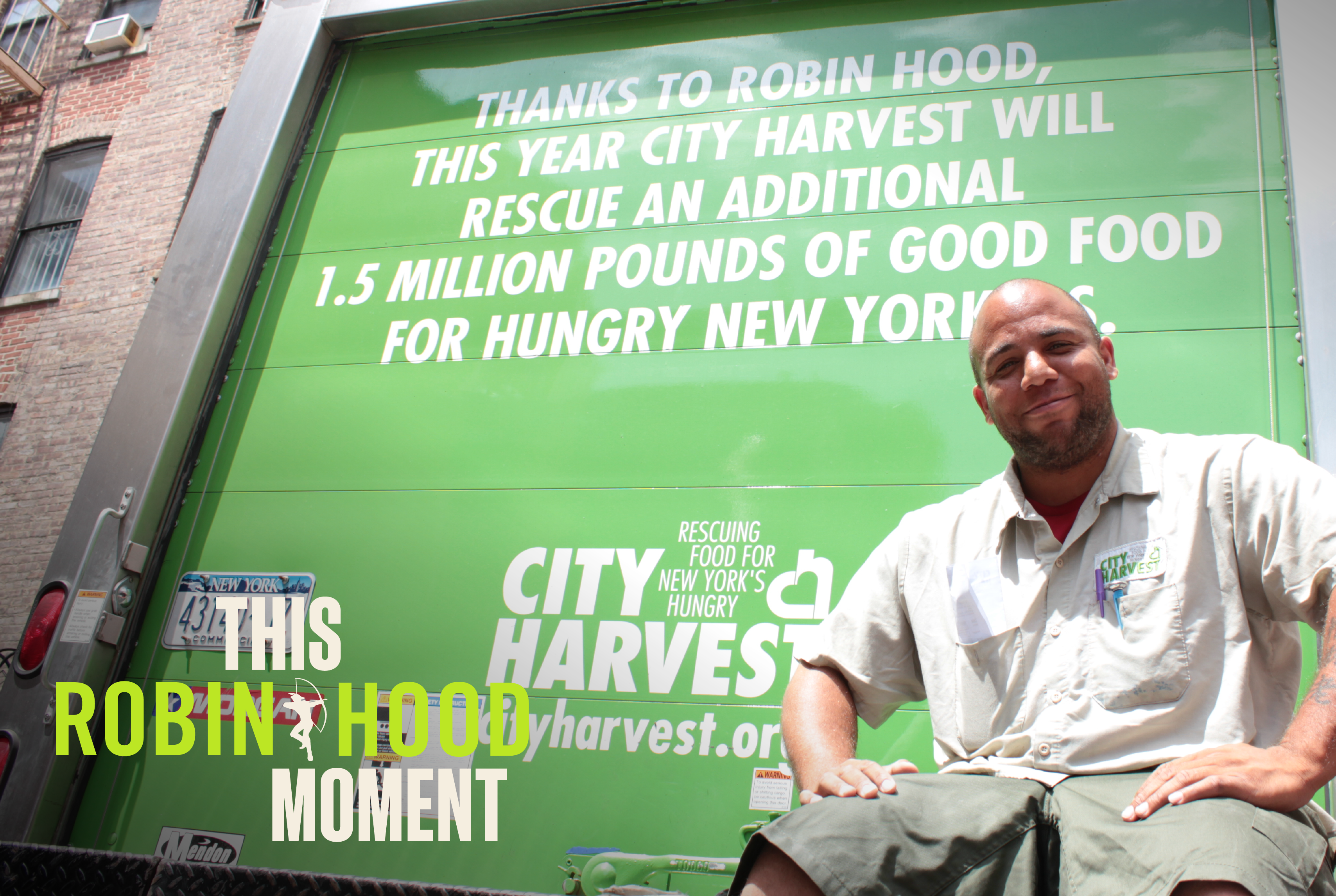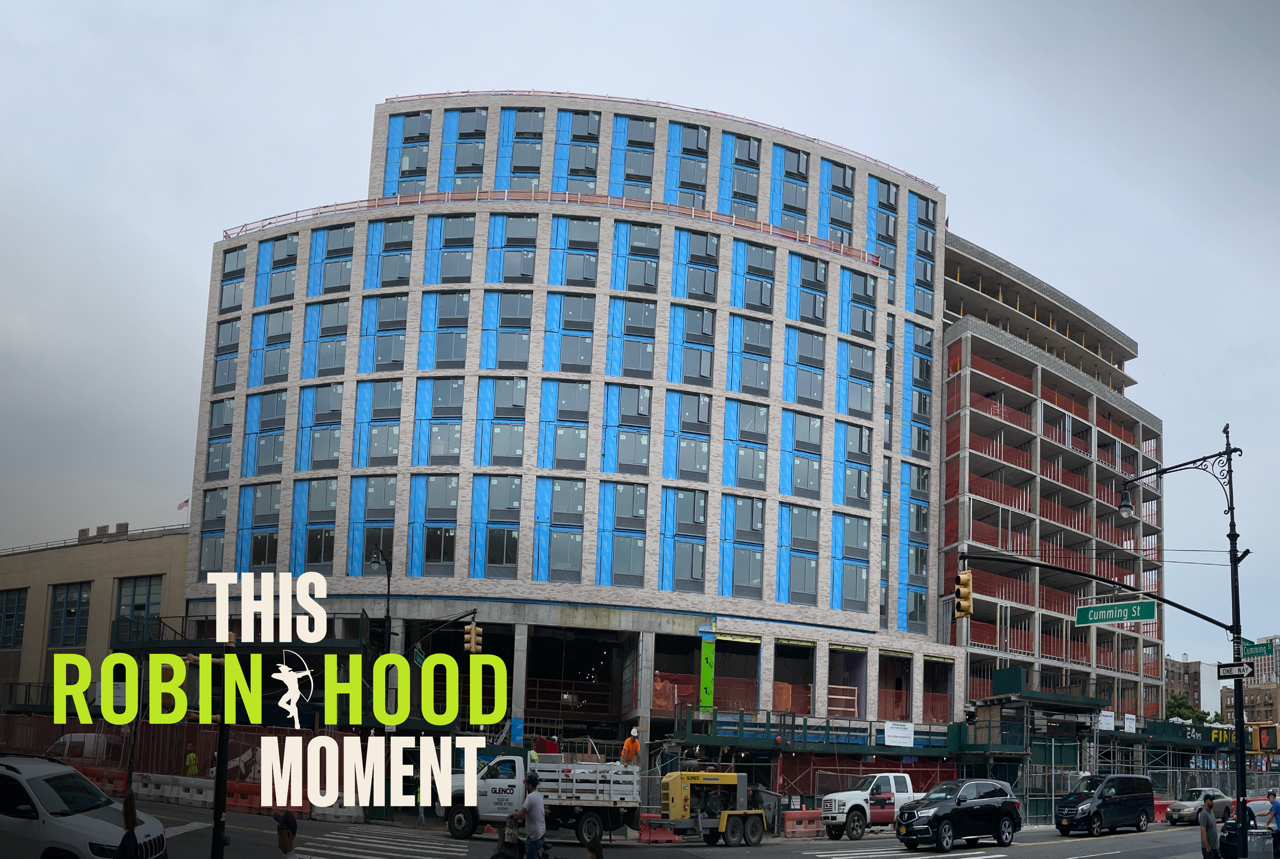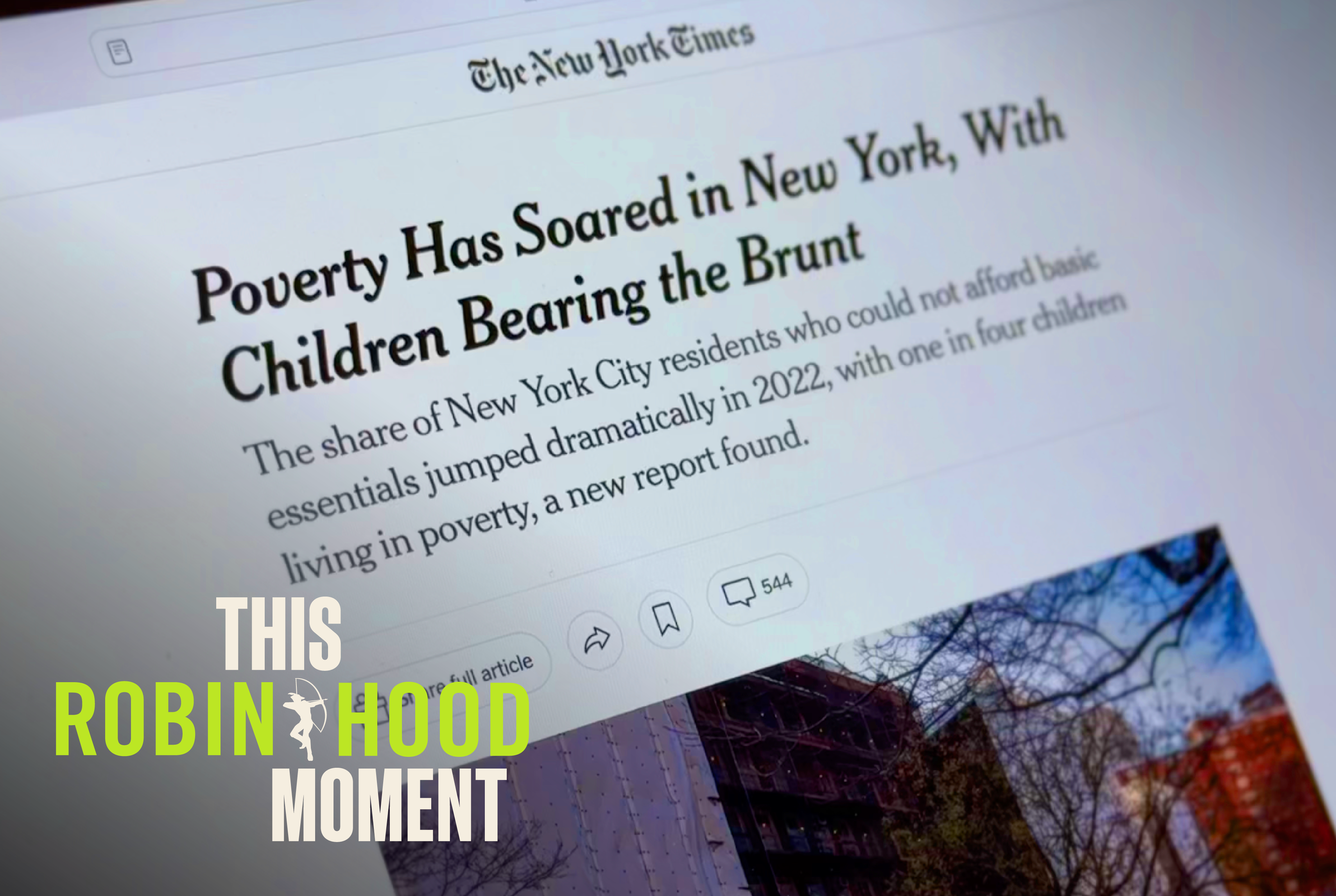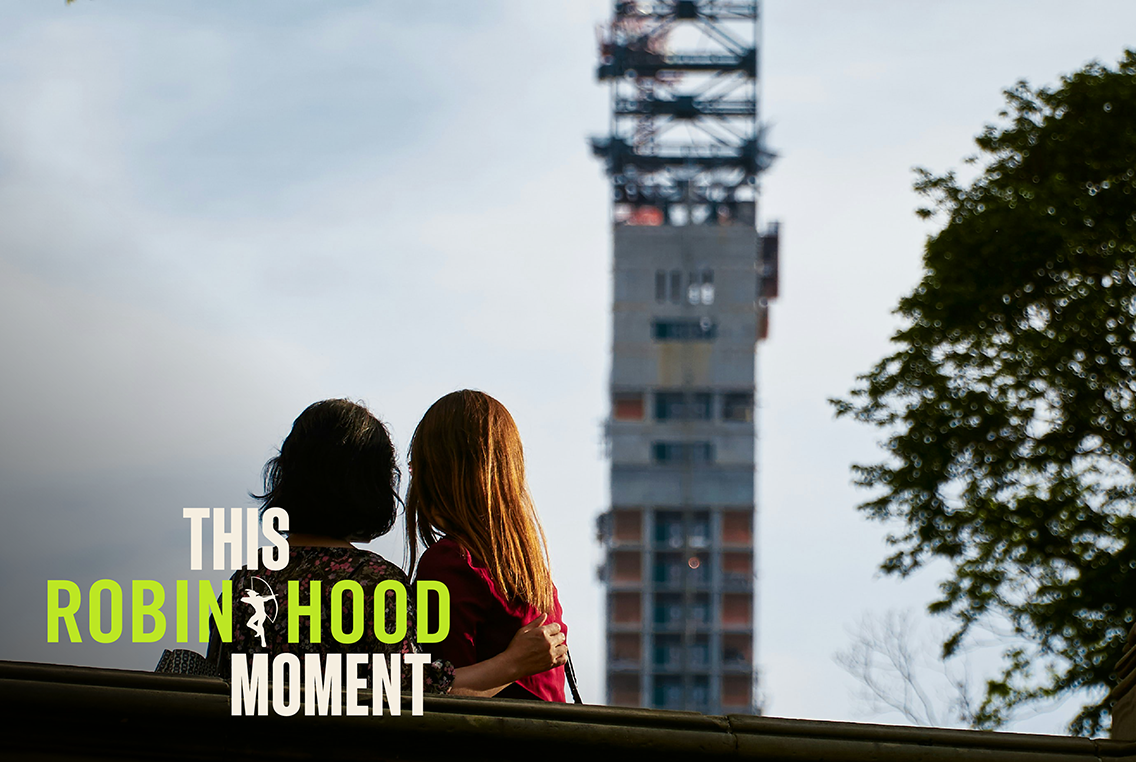Nov 18, 2024
Taking a Bite Out of Food Hardship in the Big Apple | This Robin Hood Moment
Welcome to "This Robin Hood Moment" with your hosts Crystal Cooper and Kevin Thompson. Join us as we meet Jilly Stephens, CEO of City Harvest, as she shares stories of how families struggle to put food on the table and how increasing access to food assistance will help prevent hunger from becoming the new normal for New Yorkers.
Listen and Subscribe: Amazon Music | Apple Podcasts | Spotify | YouTube
In advance of Thanksgiving each year, Robin Hood collaborates with Columbia University to produce an annual snapshot of food hardship and assistance among New Yorkers. New York City has a robust network of food providers, including pantries, aimed to make access to food easier for those struggling to feed themselves and/or their families. Despite the distribution of more than 230 million pounds of food to emergency food providers, food insecurity remains persistent and pervasive in New York City.
Join us as we meet with Jilly Stephens, CEO of City Harvest, as she paints a picture of how the profile of food pantry users has changed dramatically since the COVID-19 pandemic, and how 2-in-3 pantry users are not who you think they are.
Thoughts? Guest suggestions? Email us at info@robinhood.org.
“This Robin Hood Moment” is hosted by Kevin Thompson and Crystal Cooper. The show is produced and edited by Cory Winter, with graphic design by Mary Power. Additional motion graphics and footage are provided by Motion Array. Our theme music is from Epidemic Sound.
The views and opinions expressed by external podcast speakers and guests are solely their own and do not reflect the opinions of Robin Hood or its personnel, nor does Robin Hood advocate or endorse any individuals or entities featured on the episodes.
TRANSCRIPT
This transcript was prepared by a transcription service. This version may not be in its final form and may be updated.
Kevin Thompson: From Robin Hood—New York City’s largest poverty-fighting philanthropy—I’m Kevin Thompson. Welcome to “This Robin Hood Moment.”
[MUSIC PLAYING]
Kevin Thompson: Annually, Robin Hood publishes a Poverty Tracker report with our partners at Columbia University’s Center for Poverty and Social Policy, examining the landscape of poverty in the Big Apple and how it changes year to year and each year. Prior to Thanksgiving, we also publish a Spotlight report on how food hardship impacts New Yorkers. This year’s Poverty Tracker Spotlight report on Food Assistance reveals that one and three adults and 44% of families with children experience food hardship, meaning these are people and families that report sometimes or often running out of food or worrying food will run out before having money to buy more.
This year’s report examines food assistance efforts at the city’s more than 800 food pantries. What we’ve learned is revealing over a three year period, nearly one third of New Yorkers utilized a food pantry at least once, and nearly two thirds of pantry users were working people. For so many of us, food pantries bring to mind emergency relief, a last resort resource for individuals and families in a crisis.
But our latest data reveals that food pantries have evolved beyond this role. There actually is no typical food pantry user. Increasingly, it’s working. New Yorkers, people holding down steady jobs, but still finding that their incomes simply don’t cover all their basic needs. The report also shows a staggering rise in families with children, who now rely on food pantries, with double the number from just a few years ago.
We’re seeing more and more middle income earners, families and young people turning to pantries not as an occasional solution, but as a regular source of food. And it raises a fundamental question. In a city known for its prosperity, how have we reached a point where chronic hunger is becoming the new normal? And that brings us to our guests today.
Jilly Stephens, the CEO of City Harvest, a long time Robin Hood grantee. Since its founding, City Harvest has served as a critical safety net for the city, adapting to shifts in demand and making sure that no food goes to waste when so many are going without. But as pantry use grows, so does the question how can we respond sustainably to the scale of this need?
[MUSIC PLAYING]
Kevin Thompson: Crystal, you and I have visited several of these sites together, and seeing those lines firsthand is a powerful reminder of what so many of our neighbors are going through.
Crystal Cooper: Absolutely. Kevin. There’s something deeply humbling about seeing so many people in need of food support. Especially when you realize it’s not just people in emergency situations. We’re talking about families. People working hard and doing everything right, but still needing help to put food on the table.
Kevin Thompson: Yes, and it’s really striking. For so many New Yorkers, food insecurity has become much more ubiquitous. And this is a city with tremendous wealth. Yet we have people who simply can’t keep up with the costs, even though they’re working.
Crystal Cooper: Exactly. It’s like food pantries have gone from being a last resort to part of the regular budget strategy for people. When food is competing with rent, utilities and childcare costs. There’s just not enough money left over. And it’s families with kids, too. That’s doubled since 2019. It’s hard to see that and not feel the need for real structural solutions.
Kevin Thompson: Absolutely. And I think that’s a bigger part of today’s conversation. This isn’t just about food shortages. It’s about affordability and the gaps in support that people fall through. I’m really hoping we can get Julie’s insights on what this trend means for the future of food security. And if there are steps we can take to build a system where people don’t have to rely on pantries.
Crystal Cooper: Yes, and I’m interested to hear her perspective on SNAP to so many pantry users aren’t receiving SNAP benefits at all, even though we know it can make such a big difference. It makes me wonder what’s happening in our public assistance system that’s leaving people out. And how can organizations like City Harvest and Robin Hood help to fill that gap or push for change?
Kevin Thompson: Exactly. Well, let’s get into it. Jilly, thank you so much for joining us today.
Jilly Stephens: It’s a pleasure to be with you, Kevin and Crystal.
Crystal Cooper: Jilly, Robin Hood and City Harvest share a mission to fight poverty in New York City. We’re curious, how do you see food insecurity intertwining with other aspects of poverty, especially as the affordability crisis deepens in New York City? What role do food pantries play in this bigger picture, particularly for people living below or near the poverty line?
Jilly Stephens: Well, I think you’ve highlighted the food pantries in the city are a critical lifeline for more New Yorkers than ever. So many of our neighbors are turning to food pantries specifically because of the affordability crisis that you’ve already touched on. Rent is so high, people can’t not pay their rent. You can’t not pay your utility bills, you have to pay for childcare.
And those costs have skyrocketed. And so by the time people have paid all of those bills, there’s very little left to pay for groceries. And that’s where food pantries, historically, and even more so today, are covering the gap. We often talk about food being an elastic expense. You know, you have to pay for your medicine. Everything else has to be paid for.
But in a month where things are really tight for you, you can turn to food pantry. And it’s a fantastic network of food pantries in New York City. They’ll be there to help you. But what we’ve learned recently at City Harvest, from which surveyed pantry users, is that the food that they’re picking up from pantries can save them upwards of $70 a week, and that’s money that they can put then towards their rent check or other critical household expenses.
Kevin Thompson: So, Jilly, tell us a little bit about City Harvest and how you’re responding to this crisis. How you have found an increase in demand or if you found that it what you think this tells us about the poverty levels across the city?
Jilly Stephens: Yeah, City harvest is a food rescue organization, New York City’s first and largest food rescue organization. Food rescue is the capturing of really great, nutritious food that would otherwise go to waste, and delivering that food to a network of about 400 soup kitchens and food pantries across the five parts of New York City. We were founded 40 years ago, more than 40 years ago, in fact.
And in that time, we’ve rescued and delivered over 1 billion pounds of food. That’s great food that would have ended up in landfill, but instead ended up on someone’s plate at the end of the day. And the very nature of food rescue, the way we do it at City Harvest is it’s an emergency, right? It’s highly perishable food.
Over 70% of the food that we will deliver this year is fresh fruits and vegetables. That’s very valuable food, particularly for households with children. And so we’re not hanging on to it. We’re picking it up one day or it’s been delivered into our food rescue center in Sunset Park, Brooklyn, one day, and it’s on its way to that network of food pantries within 24 to 48 hours.
This year will rescue and deliver over 81 million pounds of food. And the reason for that is 30% more than we were doing before the pandemic, the reason that we have to grow to put more food out is because there’s so much need. As you’ve already touched on, the need is so much greater today than it was before the pandemic.
And in the food pantries that we bring food to, they are seeing more than a million more visits a month than they were saying before the pandemic.
Kevin Thompson: Jilly, I just want to pause right there and let that sink in. You’re seeing a million more visitors per month?
Jilly Thompson: A million more visits a month, over a million more, at this point, a month than we were seeing in 2019.
Crystal Cooper: Well, Jilly, I mean, that is a staggering. What does it take in order to be able to increase its by that much volume or that much output? How is City Harvest helping your partner, food pantries or your network of hot meal providers and grab and go services actually deliver and meet this demand?
Jilly Stephens: Well, we have a dedicated staff at City Harvest. One area of the organization works full time to find where is this great food? This can’t go to waste. They work hard to develop partnerships in the region pretty well ahead of our strategic plan goals. And I wouldn’t be surprised if they bring in over 81 million pounds. So we we feel it’s a crisis.
If you’re in our office, you get the sense that we know it’s a crisis. Come to our warehouse, you’ll see. Beautiful food, that I saw down there this morning included lemons, sweet potatoes, carrots, some mangoes. When we come back to be completely different food. So it’s a very rapid turnaround of highly nutritious, excellent quality food that we’re delivering.
Crystal Cooper: It is so commendable that you’re able to deliver the nutritious foods that families especially need. They have growing children who are developing and going to school. But I know that it’s really heartbreaking when we think about the fact that twice as many families are now depending on food pantries compared to before the pandemic. Let’s talk a little bit about those families. What unique challenges do they face, and how can organizations like City Harvest and Robin Berg better support them?
Jilly Stephens: It is the significant problem. We we know that many of the families that our two organizations are serving and supporting, particularly through food pantries, are struggling with those growing costs that have to be met, like rent and especially child care. I know, in fact, Robin Hood has done some research previously that shows that more than half of New York City’s families are spending a lot more than they can really afford to get the child care that their families need.
And, you know, when money gets tight because you’re spending it on rising rents and increased childcare costs, not to mention all the other fixed expenses that families have. One of the first things that will be cut from a budget is food, and especially fresh fruits and vegetables. It’s expensive, but I’ve heard from so many people that we bring food to that they don’t buy fresh fruits and vegetables because they can’t afford it.
And at the same time, you know, it’s especially important that young children have regular access to good, nutritious meals. And I know, we know all this. It’s linked to better health. It’s linked to positive cognitive and physical development, high test scores and so on. But city harvest, we’re pushed every day to put as much food out there as we can because as I touched on earlier, it frees up money in those tight household budgets for families to spend it on different things, put it towards childcare, or those are the high costs that they’re grappling with.
Kevin Thompson: Yeah, and Jilly, you know that the spotlight report that we talked about at the top of the show. It shows that two and three pantry users are employed. 71% have held a steady job since the pandemic began. Yet they’re using food pantries. How does this data challenge the assumptions people might have about food insecurity, poverty, the use of food assistance centers like a pantry? And how might it shape what you all are doing at City Harvest to meet these escalating demands in the future?
Jilly Stephens: Yeah, it’s definitely it’s a misconception that most people have that those people being served at a food pantry are homeless, or that they’re because they’re on a fixed income, or because there’s been a crisis in the household. It’s become a normal thing for families who are already pushed to, maybe hold down more than one job and in all likelihood is more than one job.
An extra piece of work, then, for that family is to piece together the food that they need to get through the week. We see older children being dispatched to go and help the family gather the food that they need. And really, it’s no way, it’s no way to live. And it’s a huge additional burden placed on families in New York City.
And the truth is, the cost of living in New York City is so high that those people who are employed don’t have enough household income to make ends meet, to meet all of those costs. And then add to that a very critical benefit that we all talk about a lot, I know, is the Supplemental Nutrition Assistance Program known as SNAP, formerly known as Food Stamps. The eligibility requirements for those SNAP benefits down to just geographically. They’re the same if you live in Idaho or if you live in New York City.
Crystal Cooper: When we think about families doing what they can on their own. In terms of strategies to fill that gap in gathering groceries. But SNAP is intended to fill that gap, right? I had no idea that they don’t consider the fact that New York is a high class city. It actually surprised us when we went through the report findings to see that there’s been a dramatic decrease from 66% of frequent pantry users receiving SNAP to just 44%. Talk to us a bit more about that challenge. You were sort of going there already about what policies or maybe outreach strategies could help bridge that gap.
Jilly Stephens: I mean, just to bring it to life a little bit more. We we know that no matter where you live, a family of four that makes more than just over $40,000 a year is not eligible for SNAP benefits. And so, in an expensive city like New York, there’s this huge gap that our neighbors are falling into between the point at which you lose access to benefits because your household income is deemed too high, a little over $40,000, and the point at which you achieve probably a bare minimum sufficiency of $100,000.
And I think it’s that gap and that number of people who fall into it that is showing up in your report, where we see that so many more pantry users aren’t taking SNAP benefits. It’s not that they’re not taking them because it’s an arduous process or they just haven’t gotten around to it. It’s because they’re ineligible. In all likelihood, and even those who are eligible, the benefits should be higher. And so they’re turning to food pantries to supplement that as well.
Kevin Thompson: Yeah, and it really does sort of illustrate why one out of every two New Yorkers lives in or near poverty; our poverty tracker annual report revealed that number earlier in the year. With that reliance on food pantries being, you know, so chronic kind of almost like this is the new normal for many New Yorkers. How do you see us shifting from this kind of emergency support to more sustainable, long term solutions?
Jilly Stephens: Policy changes are critical. And I do want to echo something I heard Krystal say earlier. And it’s something we talk about a lot at City Harvest. The people we’re serving through this network of pantries. On the whole, they’re doing everything right. They’re doing everything that society expects of them have homes, have jobs, the children’s school. And it’s really too bad, then, that they struggle to get something as basic as food onto the table, that that’s such a big job.
And so as hard as we and other organizations like City Harvest work and will always work, when you compare what we put out for every meal that City Harvest distributes, SNAP benefits provide. Nine you know, there are things that can happen at the state level to increase the SNAP benefit minimum that could be raised to $100 a month in New York State is something they’ve done in new Jersey and should be a straightforward thing to do now and then.
How can we forget the tremendous government supports we saw during the pandemic, the child tax credit that lifted so many families out of poverty overnight? You know, seeing that reinstated or enhanced at the federal level would be a very strong thing to do. And let’s look at what we can do with a measure like that at the state level as well.
There’s so much that we can do. City harvest and trucks will roll every day. We will show up every day. But the reality is it’s a drop in the bucket when you compare what a great program like SNAP can accomplish. Let’s open that up to more New Yorkers.
Kevin Thompson: Jilly, this has been wonderful. And thank you so much for joining us today. Your work at City Harvest is just a critical part of the fight against hunger in New York City. You’re you’re really an integral part of the safety net work in New York City. And I know our listeners will walk away from this episode with a deeper understanding of what’s at stake.
Crystal Cooper: Absolutely, Jilly, thank you again. We’re so grateful to have you on.
Jilly Stephens: Happy to be here. And thank you, of course, for all that Robin Hood does.
Kevin Thompson: And to our listeners, thank you for joining us on “This Robin Hood Moment.” If you’re inspired to get involved, visit Robin Hood’s website to learn more about supporting efforts to combat food insecurity and poverty. Until next time, let’s keep fighting to make New York City the world’s greatest engine of opportunity because every New Yorker deserves a fair shot.
[MUSIC PLAYING]
Kevin Thompson: This episode of “This Robin Hood Moment” was produced and edited by Cory Winter. Graphics by Mary Power. Our theme music is from Epidemic Sound. I’m Kevin Thompson, joined by the ever-insightful Crystal Cooper, for Robin Hood—New York City’s largest local poverty-fighting philanthropy. Thanks for listening.




